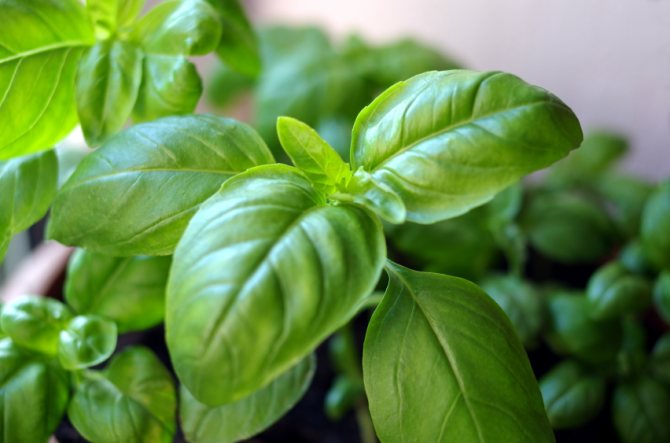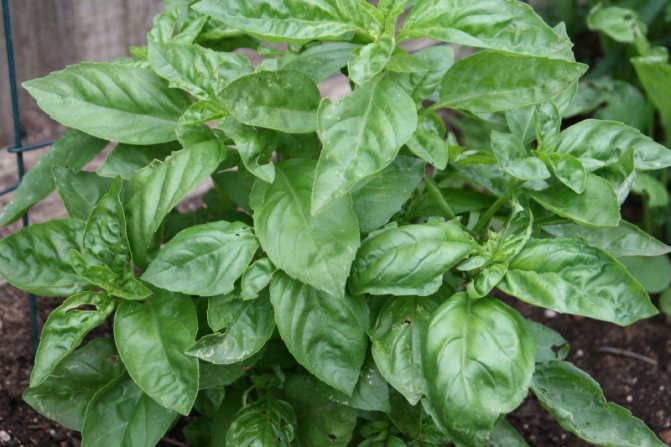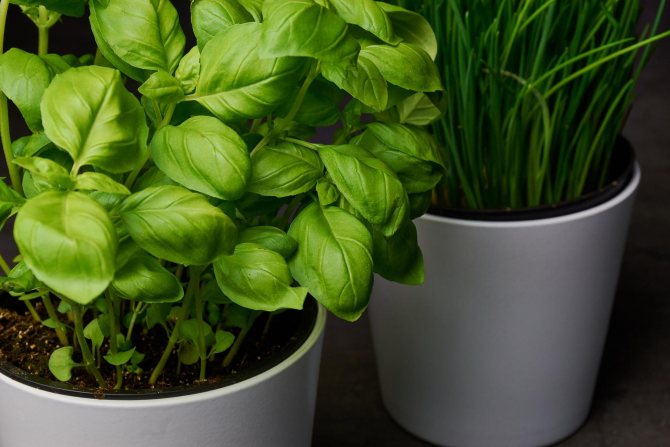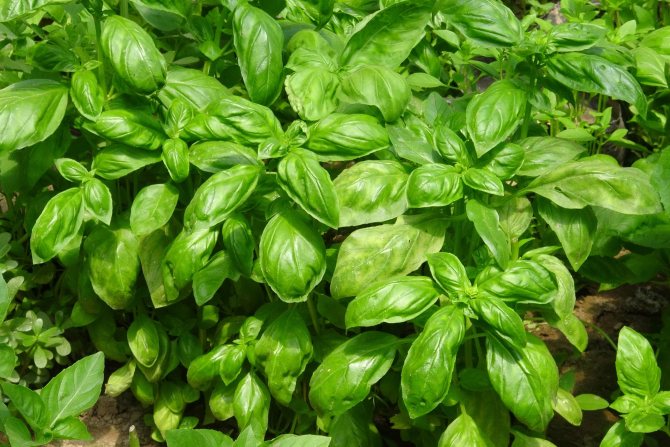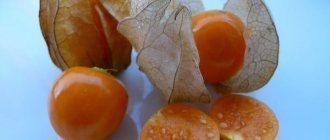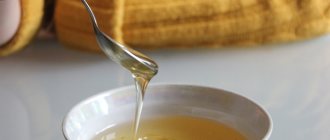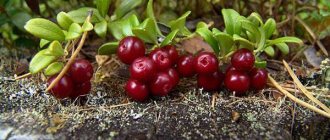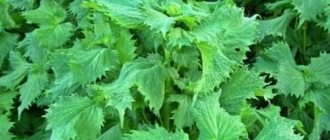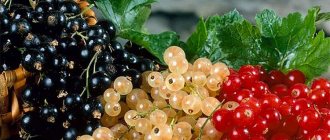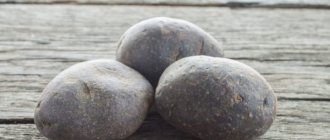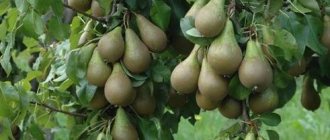The spicy bouquet of smells inherent in basil cannot be confused with anything else. This plant has been known and loved by humans for a very long time, it is used in cooking, in medicine, gardeners use it to protect other crops from insects. It came to us from the southern countries, where it grows as a "savage", and in our conditions it is possible to extend the life of this annual by taking a few plants from the garden home in pots. What kind of basil is better to choose, how to grow it correctly, what care it needs, when to plant seedlings in the open field, how to fertilize and how to protect from pests, read this article.
Basilica description
There are many ways to approach food preparation. Someone cooks in a hurry, just to drown out the feeling of hunger, someone makes an effort to this, but in the absence of imagination, the dishes turn out to be ordinary, insipid. And after work, someone turns into a good fairy or sorceress in the kitchen, who can create a real miracle from a minimum food set. But dexterous hands alone will not be enough to prepare a masterpiece. Every fairy has a magic wand, and a real housewife in the kitchen always has a magic ingredient - a spicy herb. The palm tree among aromatic herbs belongs, of course, to the basil.

Basil is perhaps the most popular herb in cooking.
Basil is translated from ancient Greek as "king, royal, royal". Its synonyms are: fragrant cornflowers, red cornflowers, darlings. In Azerbaijan, basil is called Reagan, in Uzbekistan - Raykhon, in Armenia it is known as Rean. This variety of names indicates only one thing: basil is an incredibly popular herb in many countries of the world.
Africa is believed to be the homeland of this magical plant. Basil is found wild in India, China and Iran. Nowadays, this aromatic herb is successfully cultivated almost all over the world.
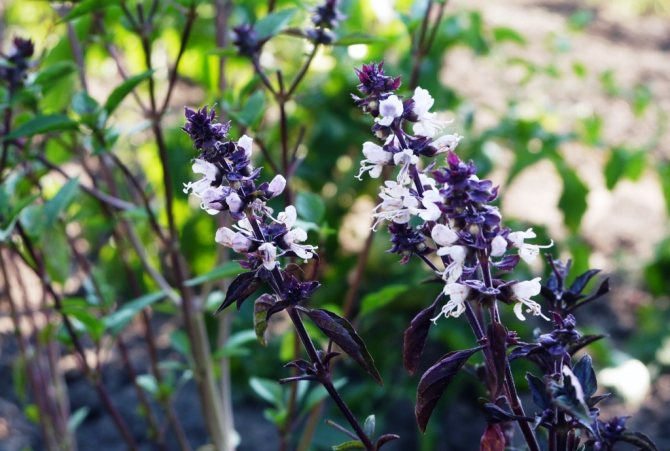

Basil is found in many countries of the world, but Africa is considered to be its homeland.
Sweet basil, or common, is an annual herb with a straight tetrahedral and well leafy stem. Height from 50 to 70 cm. The bush looks lush due to the strong branching of the stem. The leaves are oblong-ovate, located on short petioles. The surface of the plate differs depending on the species - in some it is almost smooth, while others have a bubbly leaf surface. Basil colors can be very diverse - pale green, deep purple or with a shade of red. The edges of the leaf plate are dotted with sparse denticles.
The stem, leaves and bracts of many types of basil are covered with sparse hairs, which makes the plant appear rough when touched with your hand.
The flowers are mostly white or pale pink, sometimes purple. Inflorescences are similar to tassels. The corolla is two-lipped in structure, which makes the basil a member of the Lamb family, or Lipocytes. Flowers appear in the axils of the upper leaves.
Blooming basil is an excellent honey plant.
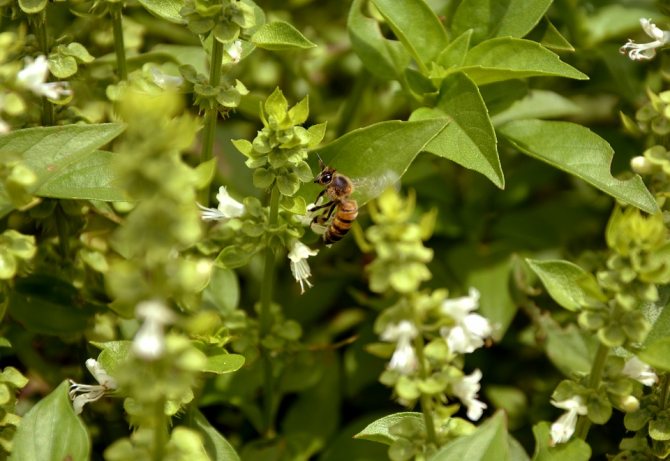

Blooming basil is an excellent honey plant
Application and contraindications
Basil gained great fame and fame precisely as a spice used in cooking. Leaves and stems are used both fresh and dried. You need to collect them before flowering. Basil has a unique aroma and taste that cannot be confused with anything. It is the variety of aromas that determines which dish is suitable for a particular type of basil. Plants that smell like caramel, lemon, cinnamon or vanilla are most often used for making desserts. Clove smell is good for meat dishes, aniseed - for fish dishes. Spicy herbs are an integral part of refreshing vegetable and fruit salads, pates, marinades, sauces, soups, preparations for the winter, tea drinks.


Basil gives homemade products a unique taste and aroma
Add basil at the end of cooking to keep its unique flavor. But be careful!
But the use of basil is not limited to culinary alone. It turns out that the plant is very useful for health and, having appeared in Russia in the 18th century, at first it was used exclusively as a medicine. For a long time, the antiseptic and antibacterial effect of basil has been noticed. But it also has the following actions on the body:
- diaphoretic,
- antipyretic,
- astringent,
- strengthening the nerves,
- antispasmodic.
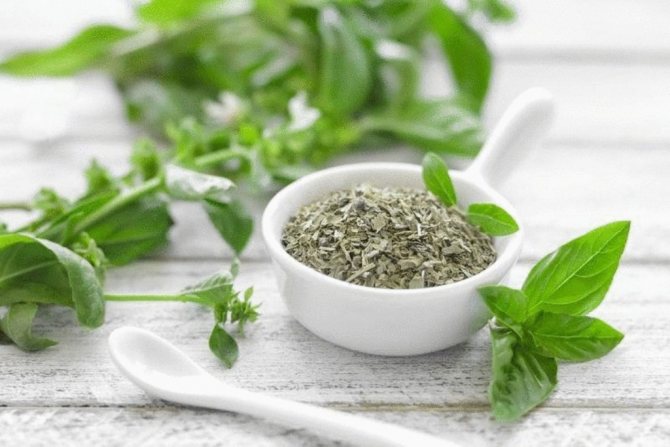

Basil is equally good both fresh and dried
But due to the high content of essential oils, there are also contraindications. Basil is not suitable for people with coronary artery disease, stroke and epilepsy. It is also necessary to limit its consumption in the following cases:
- diabetes,
- hypertension,
- thrombophlebitis,
- individual intolerance,
- age up to 7 years,
- pregnancy.


Since ancient times, basil has been known both as a medicinal and as a cosmetic product.
This plant is also widely used in cosmetology. Basil perfectly rejuvenates, regenerates and tones the skin of the face. It activates hair follicles, thanks to which the hair begins to grow faster and becomes shiny. Great for problem skin, as it is an antibacterial agent.
Variety of species
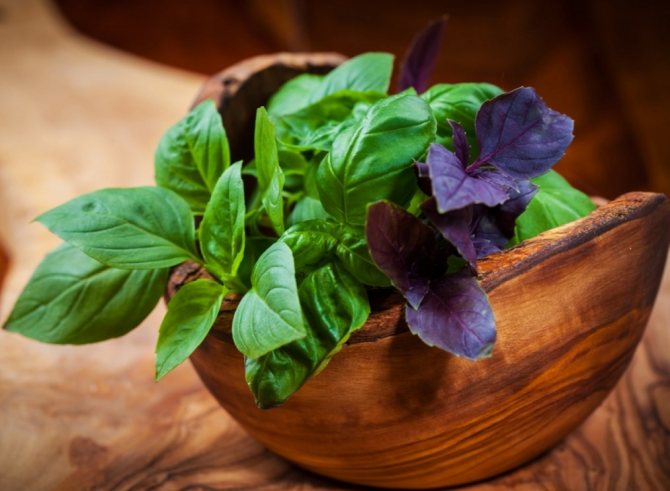

The best representatives of basil differ in aroma, taste and appearance. Basil is used in various spheres of life (cooking, folk medicine, cosmetology).
In nature, there are about 150 types of culture. The main differences in the color of the leaves, which is confirmed by numerous photos. This grass is green or purple, there are different options for intermediate shades.
When choosing a variety, early maturity, height, leaf width and other classifiers are also taken into account.
Reproduction methods
Regardless of whether you grow basil outdoors, in a greenhouse or at home on a windowsill, there are only 2 ways to propagate this plant.
- Seminal. This method is uncomplicated, although it requires little seed preparation. They are soaked in a stimulant solution, such as Epin, for 8 or 10 hours. Then it is dried by spreading it out on the fabric. Dry seeds are sown in open ground, covered with plastic wrap. With timely watering, the first shoots will appear in 1.5–2 weeks.
- Cuttings. If you already have an adult basil bush, then you can use the fastest and most convenient method. To do this, cut off a few shoots or the top of the plant and place the cuttings in a container of water. The roots will appear very quickly - after 1, maximum 2 weeks.
Perennial varieties
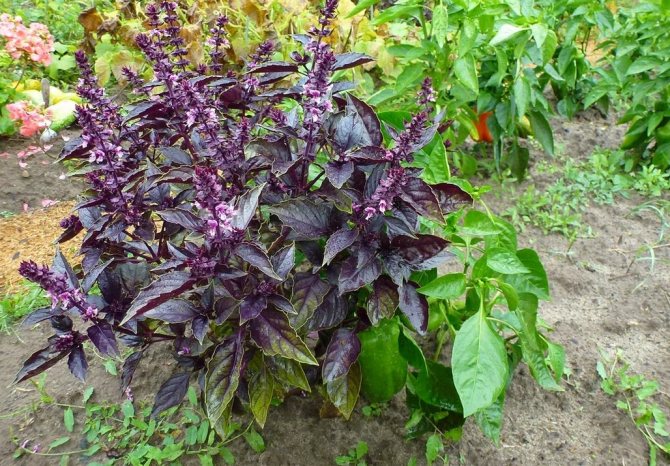

In total, there are more than 150 varieties of basil. Among this variety, there are perennials. They are most suitable for growing on windowsills. Such crops are distinguished by high decorative characteristics.
The most famous are such perennial species as Mint-leaved, Evengolny, Rama Tulasi or Fine-flowered.
On a note!
For active growth of the culture, an illuminated window sill is selected, and the plant is also provided with a stable temperature of 20-22 ° C. Loosening is carried out every two weeks. Water every 2 days.
Outdoor Basil Care
Basil seedlings are planted in open ground not earlier than the second half of May, when the threat of return frosts has passed, and the daytime temperature is stably above 20 ° C. But in each region, this period should be chosen individually - in cooler areas, planting begins in early June. In the southern regions, you can not only plant seedlings, but also sow seeds directly into open ground.


For open ground, planting basil seedlings is preferable
Legumes, pumpkins and nightshades are good precursors to basil.
Growing conditions
Basil is thermophilic, so for its successful cultivation, you need to choose the most illuminated area, protected from strong winds and drafts.
Experienced gardeners often plant the herb under young trees. They are not yet able to provide much shade and do not interfere with the basil's enjoyment of the sun's rays. In turn, the strong-smelling bush drives away harmful insects from the seedlings. This is such a natural mutual assistance.
Basil loves light soil rich in humus, the main advantage of which is good water permeability. The site should be prepared one month before planting. It is cleaned of vegetation residues, stones and dug up with organic matter - humus, compost or peat. On light loams, it will be enough to add 2 kg of organic matter per 1 m2. The landing itself is best done on a cloudy day or in the evening.
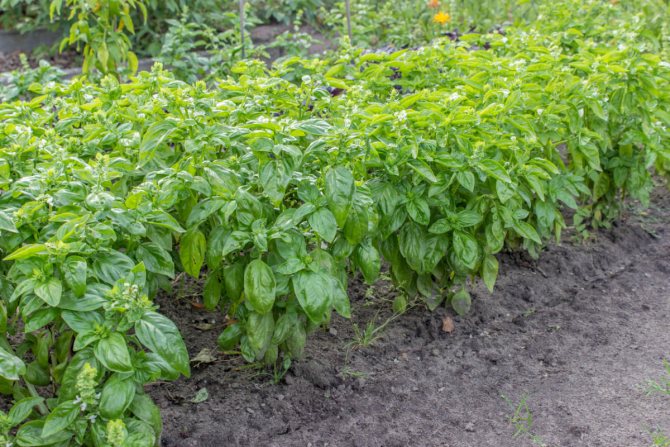

Basil grows well in open field conditions
Watering frequency
Delicate aromatic plant is very moisture-loving. Adequate watering helps the basil actively grow young leaves. But watering should be done only after the soil has dried out. Excess moisture, like its lack, negatively affects the development of the plant. Therefore, natural precipitation or elevated air temperatures significantly adjust the frequency of irrigation in one direction or another.
Don't pour cold water on the basil. Before moistening, the liquid must be defended for at least a day in a large container. During this time, the water will have time to warm up properly.
To allow the liquid to heat up enough, place a container for settling water in an open, sunny place.
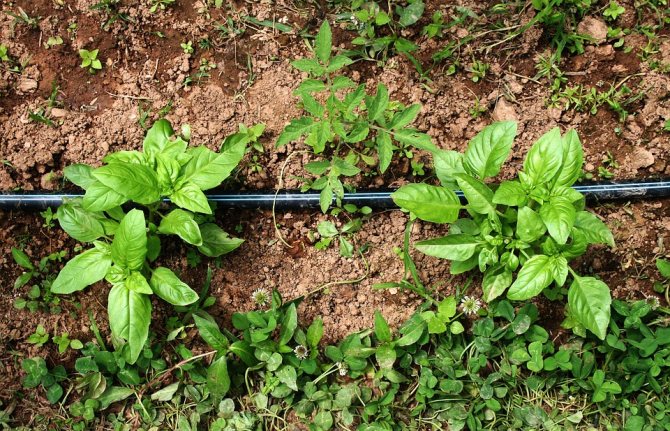

Basil is great for drip irrigation
Top dressing
To stimulate the growth of the leaf mass, you should feed the basil at least once a month. Fertilizers can be organic or mineral. But it is preferable to carry out mixed feeding.
Table: types of dressings for basil
| Type of feeding | Application rates |
| Nitrophoska | 2 tbsp. l. for 12 liters of water. Consumption 3-4 liters per 1 m2. |
| Ammonium nitrate | 15–20 g per 10 liters of water. |
| Manure | The concentrated solution is diluted with water in a ratio of 1:10. A liter of working solution is enough for 1 m2. |
| Chicken droppings | More water is added to the working solution from this type of organic matter - 1:20. |
If nutrients were introduced into the soil before planting, then the first top dressing is carried out 10–12 days after planting.
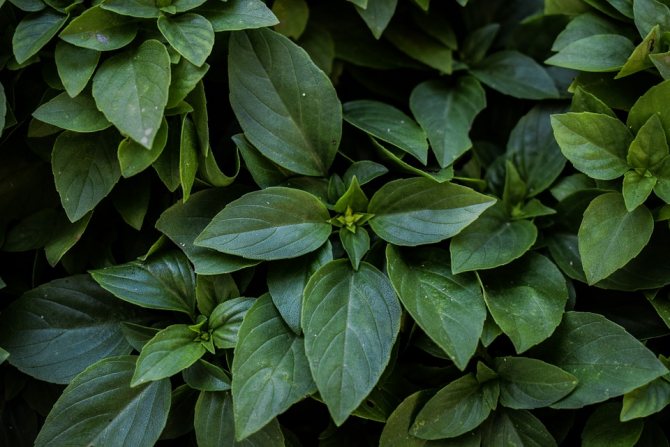

In order for the vitamin leaf mass of basil to grow, additional feeding is needed
Trimming and shaping
A special feature of the basil is its excellent branching ability. To achieve the maximum splendor of the bush, you need to remove the appeared peduncles in adult plants in time. Pinch young basil over 5-6 leaves. This procedure activates the growth of side shoots, and the spicy bush grows in breadth, rather than stretching in height.
By pruning fresh herbs periodically, you help the basil keep its foliage juicy throughout the season.If the inflorescences are not removed, then the leaves begin to taste bitter, and the lower ones quickly turn yellow and dry.


Pinching basil stimulates the growth of side shoots
Feeding
It is imperative to feed the basil, because, as already mentioned, basil does not receive enough necessary elements from the soil on the windowsill, this will have to be corrected with frequent and regular baits. The plant will be grateful for the simple more familiar fertilizers made from compost and based on humates. Fertilize the soil once a month according to the concentration indicated on the package, and then your homemade basil will delight you with green, juicy leaves that can be safely added to a salad.
Growing basil in a greenhouse
The greenhouse reliably protects plants from frost. The microclimate without sharp fluctuations in temperature at different times of the day and with a constant level of humidity allows you to get greens much earlier than in the open field.
Growing features
Growing basil in greenhouse conditions is quite simple and profitable. Indoor spaces have many advantages, including:
- getting early greens,
- reliable protection from bad weather,
- minimal damage from pests and diseases.
The greenhouse makes it possible to grow a vitamin product not only during the season, but all year round. True, for this you need to have a heated room to maintain the air temperature at 22-28 ° C. So that the plants do not suffer from a lack of lighting, preference should be given to durable and transparent materials, for example, glass or polycarbonate, and inside it is necessary to have additional lighting. Another requirement for greenhouses is the presence of vents for ventilation.
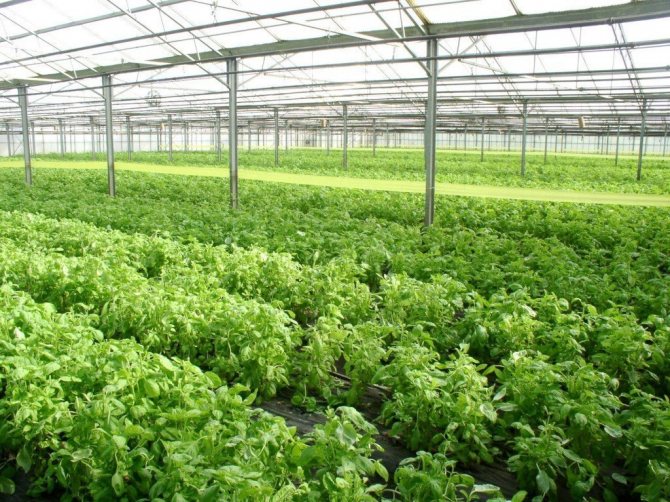

Greenhouse conditions provide excellent opportunities for growing basil all year round
How to grow basil in a greenhouse
In a greenhouse, basil can be grown quite successfully by seed or seedlings. In one case or another, planting is carried out earlier than in the open field. Seeds are sown in early March or April. During this period, the spring sun has time to warm up the greenhouse. Seedlings in the southern regions can be planted in mid or late March. In places with cooler climates, you need to wait a little with this job.
Seed planting
Seeds are planted in well-moistened soil to a depth of no more than 1 cm. The crops are covered with plastic wrap. The first shoots usually appear after 10 days. When all the seeds sprout together, be sure to thin out. The distance between bushes in a row should be 20-25 cm, depending on the growth rates of the planted variety. Leave at least 30 cm in the row spacing.
Video: how to plant basil seeds
Planting seedlings
Seedlings are grown in special containers. The seeds are deepened half a centimeter into the moistened soil, the distance between them is 3 cm. In order for the seedlings to successfully sprout, the container is covered with glass or plastic wrap. Such a shelter will help maintain a temperature of 25 ° C inside. If the seedlings are weak, then after the first true leaf appears, they need to be fed with a nutrient solution. To do this, mix phosphorus, potash and nitrogen fertilizers in a ratio of 5: 3: 2 with 10 liters of water. A pick is carried out when 2 leaves have appeared on the seedlings. Seedlings are transplanted into the ground when the plants have at least 4–5 leaves.
Soil requirements
As a rule, for spring planting, the greenhouse begins to be prepared in the fall. A layer of earth up to 25 cm thick is removed and the vacated areas are filled with a mixture of garden soil with humus or peat, with the addition of sand to make it friable. You can go the other way - just dig up the soil, having previously evenly scattered the fertilizer over the surface. For each m2, it is necessary to add from 3 to 5 kg of organic matter, 25 g of superphosphate and 15 g of potassium salt.
If for some reason you were unable to prepare the land in the fall, do it no later than 2 weeks before the start of work.
Watering
The irrigation schedule for growing basil in a greenhouse does not undergo drastic changes due to the stable indoor conditions. Water more often and generously in the first month after planting. Then reduce the frequency of humidification so that excess moisture does not lead to disease. Water a mature plant when the topsoil is dry enough.
As a rule, watering the basil once a week is sufficient in a greenhouse. But if the conditions of the microclimate inside change, then the humidification schedule will also change.
Watering should be done with warm water. For the procedure, you will need a watering can with a nozzle in the form of a wide spray. Drip irrigation has also proven itself very well.
To maintain normal humidity inside, it is necessary to conduct periodic ventilation. Condensation accumulating on the glass must be removed. When airing, the time of which correlates with the weather conditions, try not to create drafts.


Basil is demanding on moisture, but in the greenhouse you need to strictly control the level of moisture
Top dressing and pruning
These procedures are carried out in the same way as for growing basil outdoors.
Video: growing basil in a greenhouse
Rare varieties
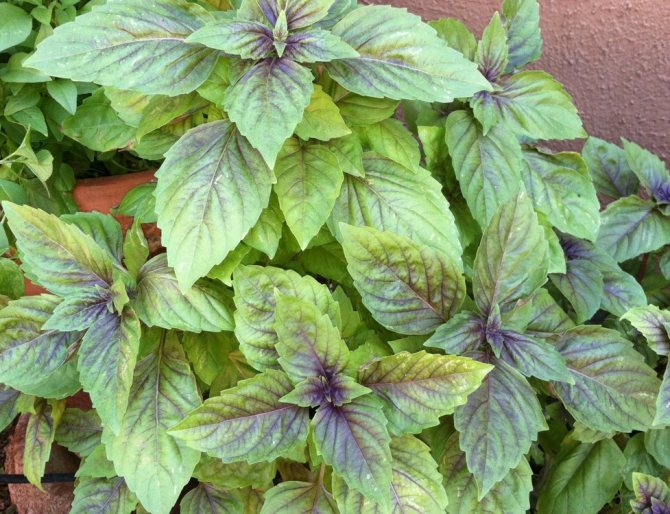

Among the variety of different species, there are rare varieties, for example, Lemon. This is a variety with an early ripening period, you can cut off the seasoning for 40-45 days. The bush is low. Leaves are used fresh or frozen, dried.
Another early rare type of basilica is Rubra. Low representatives of the basil, strewn with purple leaves with red tints. Differs in a rich smell.
Edwin's Basil is an early species. You can collect delicious spices already for 40 days. Light green leaves acquire an intensely spicy aroma.
Among the wide variety of the best varieties of basil, it is easy to find the right one. To get a lot of tasty and healthy greens, it is important to correctly provide the plant with germination conditions, as well as to properly care for the crop. So that the greens do not lose their bright taste, they are cut off even before the flowers appear.
Growing at home
If you love basil and want to have these fragrant greens on your table every day, try growing them at home. The lesson is fun and easy. But there is one little secret. Low-growing varieties of basil have proven themselves well as a pot plant. There is a long list of them, but still we will offer some of them:
- Dwarf,
- Basilisk,
- Troll,
- Marquis,
- Philosopher,
- Compatto.
Growing basil as a houseplant was a popular activity in ancient Rome. They believed that the aromatic herb brings love, happiness and good luck. By the way, in the Mediterranean countries they still believe in it. Therefore, almost every balcony there is decorated with this spicy plant.
At home, basil is grown in the same ways - by seeds and seedlings. But first you need to choose the right soil mixture - it should be light and permeable. Be sure to place the drainage at the bottom of the pot, as stagnant water in the roots will lead to the death of the plant. And of course, observe the thermal regime. Basil grows well in a warm sunny window, away from drafts.
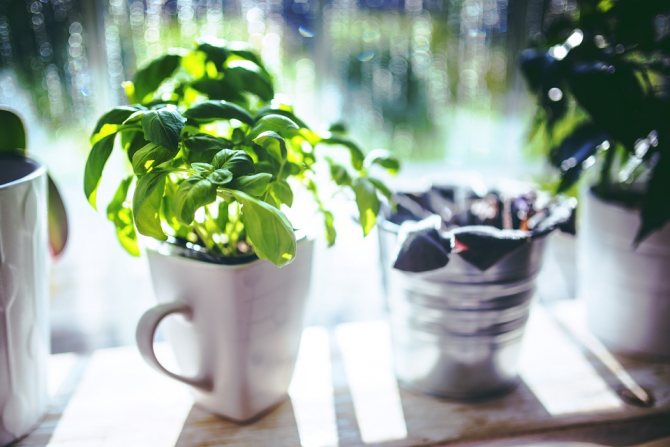

Basil has been popular as a houseplant since ancient Rome.
Differences in height
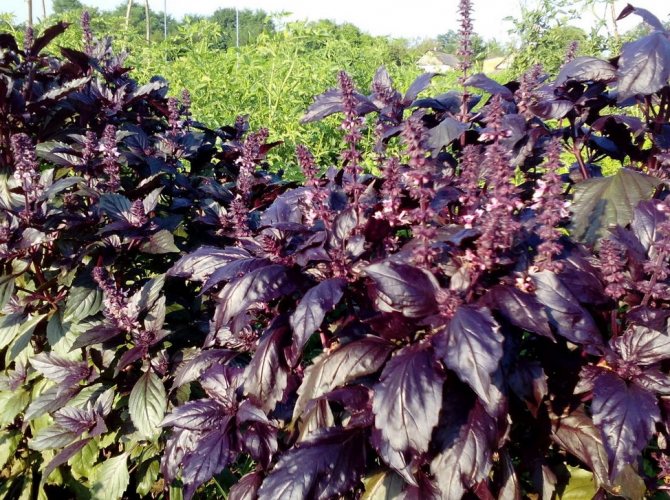

Plant species are classified by growth. Each variety has its own characteristics regarding the use and cultivation.
- Low-growing species. These are compact bushes that are preferable to plant at home. Undemanding. They are simply moistened, systematically fed and spicy greens are cut off. The maximum height is 30 cm.The most common are Basilisk Basil, Thai Queen, Stella, Malachite, Velvet, Gourmet.
- Medium-sized varieties are considered a versatile seasoning. They are planted in private farms and in industrial fields. The height of such plants reaches 60 cm. Bright representatives are Smuglyanka, Rarat, and Tender.
- Tall varieties are the most demanding and capricious. The higher the growth of the basil, the more difficult it is to care for. Handling and spraying are difficult. Height over 60 cm. Dreamer, Dreamer, Ruby of Cairo are widespread.
Basil compatibility with other plants
As you know, in the cramped conditions of small gardens, many summer residents resort to tricks - compatible or compacted plantings. The same method is often used in greenhouses. So that the plants do not oppress each other, but, on the contrary, help develop, you need to choose the right neighbors. Basil in this regard is a convenient plant. It grows well surrounded by many vegetable crops.
- For legumes, basil is not only a great neighbor, but also a protector. Its bright aroma repels the bean weevil.
- It improves the taste of leafy and head salads, tomatoes.
- It gets along well with kohlrabi, pepper, corn, zucchini, asparagus.
But there are vegetables and strong-smelling plants with which the basil does not add up. They oppress each other, so it is not recommended to plant basil next to the following crops:
- cucumbers,
- cabbage,
- radish,
- marigolds,
- marjoram,
- rosemary.


Basil is a great neighbor for many vegetable crops
Color classification
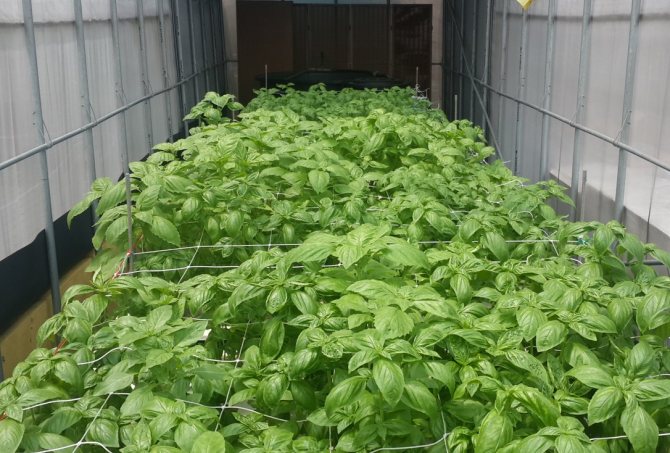

The division into groups according to the color of the ground part is widespread. There are cultures with purple or greenish leaves. But scientists are constantly developing new varieties with different colors. The difference between green and purple basil is not in appearance, but also in taste and smell, as well as in the scope of use.
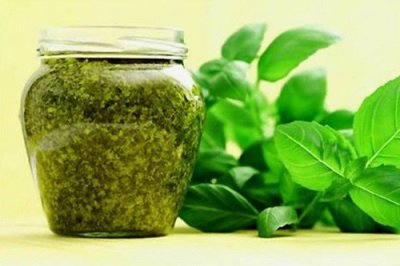

Pests
Basil is also resistant to pests. The strong scent can scare off most of them. As a rule, mass destruction of plantings by harmful insects is not observed. But young and weakened plants can suffer from aphids or meadow (field) bugs. Sucking pests feed on the cell sap of plants, which leads to a slowdown in their growth, and then to the drying of the leaves.
Compliance with the preventive measures described above will help prevent uninvited guests. Well, if they appear, folk remedies will help to cope at an early stage. Pests are scared away by herbal decoctions:
- tansy,
- wormwood,
- bitter pepper
- Luke,
- dandelion,
- garlic.
Processing is carried out several times at weekly intervals. The ash solution will do a great job - pour 300 g of ash with boiling water, simmer for half an hour over low heat, cool and strain. Dilute the resulting volume with water to 10 liters.
If you cannot do without chemicals, then use Karbofos, Actellik or Akarin.


The meadow bug is not afraid of strong aromas, so it can visit the basil garden
Variety in early maturity
When choosing a variety for their site, they are guided by other indicators, for example, a description of the ripening time.
| Early maturity | Time until ripening | Name |
| The earliest | 15-25 | Pepper aroma, Dragon, Delight, Gnome, In memory of Yuri Fadeev, Pearl of the Moscow region |
| Medium early | 30-45 | Karakum, Black prince, Emily, Marquis, Marian, Cinnamon aroma, Malachite, Rumba, Rosie, Pomegranate nutmeg, Lemon miracle, Purple fireworks |
| Medium term | 50-65 | Naughty man, Gourmet mint, Fragrant beauty, Dark night, Lemon slices, Gourmet clove, Freshness, Sanka, Purple stars, Opal |
| Mid late | More than 70 days | Dreamer, Bader, Violet |
Mid-season and later varieties are planted mainly in countries with warm climates. But the early and mid-early varieties are used in the regions of the middle lane.
Growing problems
Although basil is not a finicky plant, it can sometimes be problematic to grow it. Most often this can happen at home or when grown in a greenhouse.
Table: problems encountered and how to fix them
| Problem | Cause | Elimination |
| Basil is pulled up |
|
|
| Leaves dry | The plant suffers from high air temperatures and low humidity. |
|
| Leaves curl |
|
|
| Light, parchment-like spots appear on the leaves | Perhaps it's a sunburn. |
|
| Grows poorly |
|
|
| Basil blooms | This is a natural process. |
|
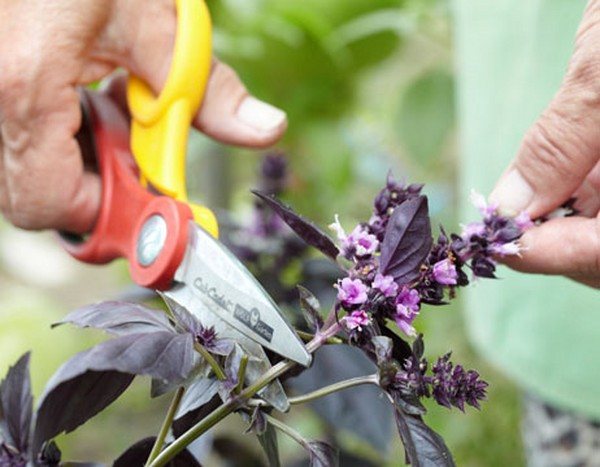

To prevent the basil leaves from being bitter, the inflorescences must be cut off.
Interesting Facts
Many stories, legends, legends are associated with the seasoning.
- The ancient Egyptians used seasoning for mummification and made wreaths out of it. Because of this, basil has long been considered a symbol of death and was not used for food.
- There is a legend according to which Salome hid the severed head of John the Baptist in a pot of basil.
- The ancient Romans and Greeks sowed the seasoning with wild shouts and curses. It was believed that this was the only way the seeds would sprout.
- In the Middle Ages, people believed that a basil leaf, forgotten under an inverted cup, would turn into a scorpion. Some believed that even inhaling the scent of the seasoning would cause the scorpion to wake up in the head.
- But still more often basil was considered a symbol of love. In Italy, it was even customary to put a pot with it on the windowsill, as a conditional signal for a lover.
- And Indians believe in the divine protection of the seasoning, its ability to cleanse a bad aura and strengthen the immune system. The plant is the second sacred after the lotus.
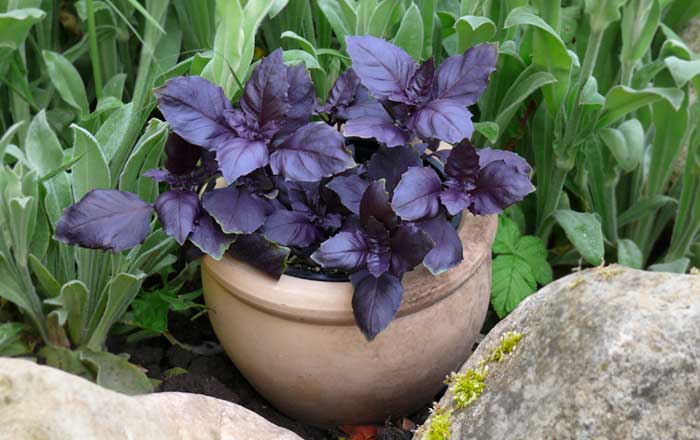

Did you like the article? Like it ♥, subscribe to our channel and you will be one of the first to know about new publications!
And if you have something to share - leave your comments! Your feedback is very important to us!
Growing secrets
If you first decided to grow this useful plant in the garden, first carefully study all the secrets for its successful cultivation:
- For the basilica, choose the sunniest place. It is not bad if the bed is protected from the north by dense plantings of other plants.
- In southern regions, sow seeds or plant seedlings only in well-heated soil. If you live in cold climates, you need to grow basil either in greenhouses or in a room on a windowsill.
- Break out or cut off the resulting inflorescences in time. This stimulates the branching and growth of delicate vitamin greens.
- Basil loves a clean garden, so weeding and loosening should be done at least 7 times during the growing season.
- If you plant basil with peppers or tomatoes, then take care of the spicy herb much easier. When caring for vegetables, you pay attention to the basil at the same time.
Flavored species
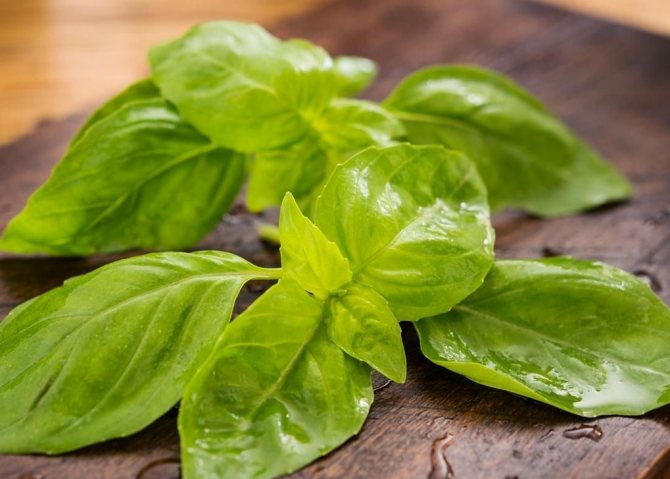

Another common grouping is by fragrances. Different types differ in a specific aroma, therefore they are added to different dishes.
It may be interesting Why dill does not grow and how to influence the state of greenery Features of growing rosemary on a plot in the Rostov region Rules and features of growing basil for seedlings
- The lemon variety has a specific smell of citrus, lemon balm, camphor. They are added to desserts and ice cream, as well as to marinades and main dishes. Bushes of small height (30-35 cm) with abundant greenery.
- Spicy clove basil. Annual with jagged leaves of a light green hue. They grow up to 50-60 cm. Has a rich taste of cloves, used for winter harvesting.
- Pepper species (Rosie, Magic of the East, Aramis, Osmin, Pepper). Greens are characterized by a sweet-spicy taste. In each of the varieties, peppery shades can be traced. They are rich or subtle.
- Clove-pepper varieties (Phantazer, Marquis, Basilisk). Spicy seasoning is widely used in cooking. The aroma of cloves is in perfect harmony with allspice.
- Basil Caramel (varieties Lubimchik, Red Ruby, Caramel, Vanilla Aroma, Brown). The greens of these plants give baked goods and desserts a sweet, spicy taste with a slight sourness.
- Vanilla varieties. Ideal for adding to pastry baked goods. They are characterized by juicy, fleshy greens. A prominent representative of this group is Vanilla Aroma.
- Anise varieties (Delight, Gourmet, Anise, Aperitif).
- Peppermint varieties have a pronounced black pepper flavor and mint notes. A prominent representative of this group is Greek basil.
For winter harvesting, varieties with a greenish (Broadleaf, Greek, Basilisk) or purple (Cairo Ruby) color are chosen. Scientists have developed the Tempter variety exclusively for conservation.
Collection and storage of the basil
To use basil as a flavoring additive to food, you can pick off the leaves or the top of the shoot when the plant is 15 cm tall. Do this carefully so as not to accidentally pull out the entire bush.
By the time of the beginning of flowering, and this is approximately the end of July-beginning of August, the leaves have already accumulated a sufficient amount of essential oils. It is during this period that it is necessary to collect the sheet mass for harvesting for future use. You can save vitamin greens in different ways:
- to freeze,
- salt,
- preserve.
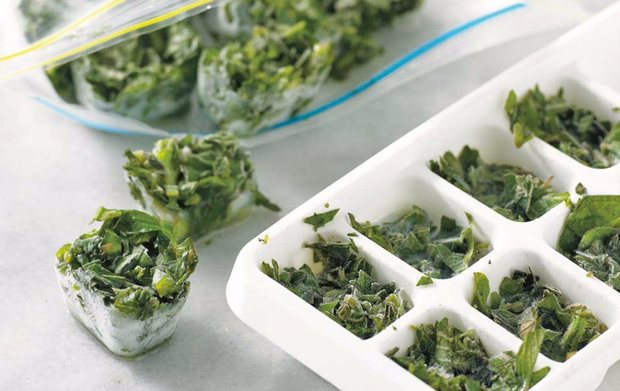

Frozen basil does not lose its beneficial qualities
But the most common way of storing vitamin herbs is drying. It's very simple to prepare basil in this way:
- Pluck or cut off the plant's shoots.
- Collect 5-6 twigs in small bunches.
- Hang upside down in a well-ventilated dark area.
- After a few weeks, the leaves will naturally lose moisture.
- Store the finished product in a glass jar with a tight lid.
You can also dry basil in the microwave, electric dryer and oven.
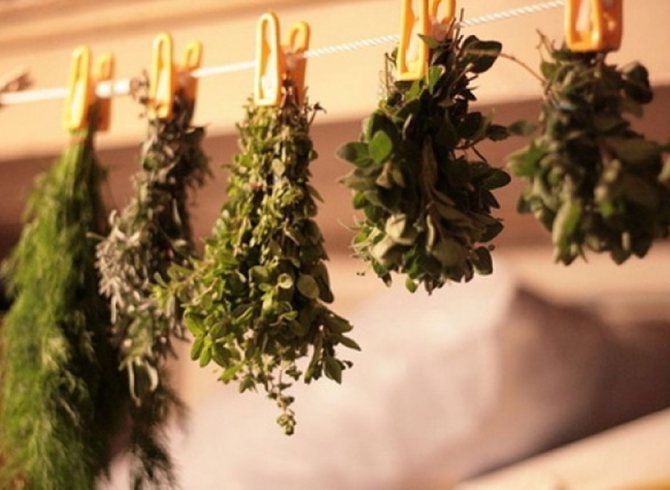

Like any aromatic herb, basil is easy to dry naturally
Beneficial features


Let's continue to praise this wonderful green, it has a long list of beneficial qualities. It strengthens the immune system, is useful in cancer and HIV. As well as:
- has antiviral and antifungal properties;
- improves asthma;
- it has wonderful properties as an antipyretic agent;
- useful for flatulence;
- helps in the fight against insomnia;
- is a diuretic;
- actively reduces cholesterol;
- reduces toothache and pain during menstruation, and a decoction from it helps to get rid of bad breath.

